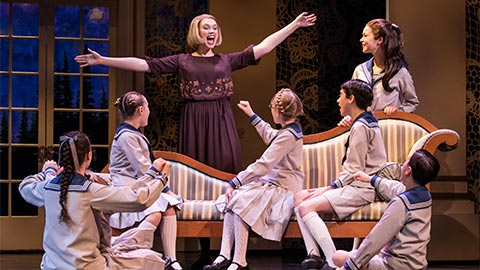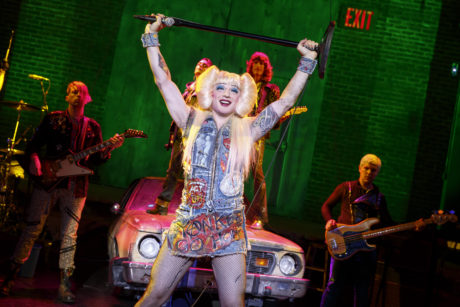 It’s amusing to me that on the 100th anniversary of the birth of the namesake of the John F. Kennedy Center for the Performing Arts, there are two popular, quite different musicals on either end of the Grand Foyer.
It’s amusing to me that on the 100th anniversary of the birth of the namesake of the John F. Kennedy Center for the Performing Arts, there are two popular, quite different musicals on either end of the Grand Foyer.
What if ticket holders to the traveling national tour of “The Sound of Music” made it by mistake to “Hedwig and the Angry Inch” or vice versa?
But are they so different? Both are musicals representing a chunk of the 20th century. Both are Tony winners with celebrated revivals. Both are vaguely about family relations fractured and reformed elsewhere. And in both, the legacy of Germany looms.
In “Sound of Music,” it’s Hitler’s Austrian takeover that hangs like a cloud over the family musical — the Von Trapp Family singing beneath huge swastikas near the end is still a visual shocker. And the titular character in “Hedwig” was born in a divided Berlin before transplanting to a Kansas trailer park and starting a career in the end of glam rock that used Nazi symbolism as a shock (though there seemed none in the production).
Both lavish traveling productions are satisfying and reassuring to their quite different partisan audiences. Both have to shake off impressions of earlier incarnations.
For “Sound of Music,” that means generations of fans of the 1965 film that still is a ratings winner on broadcast TV annually. There’s no getting over the Julie Andrews version, though it seems that this Fraulein Maria, a peppy young Charlotte Maltby has succeeded in doing so (her Captain, the soap star Nicholas Rodriguez, however, took every stiff cue of Christopher Plummer).
For those who grew up memorizing the film, the original version by Richard Rodgers and Oscar Hammerstein II may be a shock — shuffling songs in different order, and having the convent play a much bigger role than before.
Indeed, not only do the nuns there sing “How Do You Solve a Problem Like Maria?” but Maria joins in with the Reverend Mother to sing “My Favorite Things” very early on. Maria sings “Do Re Mi” as an introduction to the children, and “The Lonely Goatherd” to calm them during a storm.
The Captain talks a lot about “Edelweiss” but doesn’t get around to singing it until the festival. Most surprising, perhaps are the songs by the Baroness (Teri Hansen) that never made the movie.
The heavy Catholic feel tends to blunt the romance between the Captain and his governess. All it takes, it seems, is a dance and a kiss and they’re talking marriage. More convincing is the blossoming love between Marta and future Nazi youth Rolf (Paige Sylvester and Austin Colby). iIt’s quite convincing that she too seems younger than her movie counterpart, and the rest of the talented children are smaller too (they include Elliot Weaver, Stephanie DiFiore, James Bernard, Taylor Coleman and Anika Lore Hatch and perhaps the best name on stage, Dakota Riley Quackenbush).
Like most ambitious traveling musicals, this one delivers on lavish costumes (Joan Greenwood) and scenery (Douglas W. Schmidt), heavy on the shards of light (by Natasha Katz) and shadow in the abbey, with big chandeliers and staircases in the mountain mansion. For all they sing about the mountains, though, they could be more inspiring than a flat painting.
The biggest name associated with this revival, which has no plans to make it to Broadway, is three-time Tony winner Jack O’Brien, so it’s really the Rodgers and Hammerstein star power that attracts audience.
And this “Sound” delivers on the emotional scenes of the film, as when a melting Captain finally sings along on “Sound of Music” at the end of act one, or that adorably corny, “So Long, Farewell” done twice.
The best voice in the group, though, is Melody Betts as the Mother Abbess, belting out a ringing “Climb Every Mountain” to end both acts.
While “Sound of Music” presides in the Opera House, “Hedwig” takes its stand at the Eisenhower Theatre, where, they would lead you to believe in this traveling version of the 2014 revival, that the band has only been allowed use of the stage because of the sudden closure of “Hurt Locker – The Musical,” fake Playbills of which still scatter the floor (and are must reading).
That also explains why Hedwig and his band have to play amid the bombed out cars on stage (which provide their own stagecraft). Just outside the rear exit, we are led to believe, a big concert by an ex is going on in the National Mall.
The key to each performance is specificity and each stop is tailored for its city. There is of course a wealth of material to use from Washington, from the current White House occupants to the development of H Street corridor. More than that, the talented lead Euan Morton, ad libs about late arrivers, front row habits and plants a kiss on random people in the audience.
He’s hilarious, and better than that, has a strong voice well suited for his character — not too Broadway, as others in the role might have been, and not too rock ’n’ roll. The surprise about “Hedwig” by Stephen Trask and John Cameron Mitchell is that there are as many ballads as there are rocking anthems. And the good thing about the ballads, which usually go with the told story about a botched sex change operation and other humiliations, is that they are not matched with blinding strobes that over accentuate the loud numbers.
A hit off-Broadway for years in dives where it was probably it was best set, “Hedwig” has hardly lost its punch from its advancement to Broadway and now, the Kennedy Center. It shows that both a rock musical can deliver content with thrilling vibrancy and that glam rock is not to be dismissed as a bygone rock genre.
I still sort of wish that there was a crossover song that could be performed at both Kennedy Center musicals. I suggest an upbeat version of “So Long Farewell” in the encore.
“The Sound of Music” continues through July 16 and “Hedwig and the Angry Inch” continues through July 2, both at the Kennedy Center in Washington, D.C.
